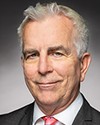Thank you, Madam Chair.
Madam Chair and members of the committee, thank you for inviting me to this discussion. This session is my first time, so I'm nervous and excited.
I'm joining you from the Vaccine and Infectious Disease Organization. We are based at the University of Saskatchewan, which is situated on Treaty 6 territory and the homeland of the Métis.
I just had the privilege of coming back from the Royal Society of Canada's G7 One Health research summit at Lake Louise last week. At the meeting it became very clear that we need to focus on perhaps two things to protect the lives of Canadians from infectious diseases. The first is to identify and address the drivers of emerging infectious diseases—and this includes lots of factors, including climate change, land use change and deforestation—and the second is to develop countermeasures and policies to protect human lives and the lives of our livestock from emerging microbial threats.
If I may draw your attention to some statistics, greater than 70% of emerging infections have an animal origin, and we've only sampled and identified a fraction of microbes, including viruses, that exist in our wildlife. We know even less about their potential to infect livestock species and humans. Even for pathogens that we do know exist and that can infect, vaccines and therapeutics remain unavailable.
Some of these pathogens, unfortunately, have civilization-devastating potential. If we look at Nipah virus, we see it has a 40% to 70% mortality, so 40% to 70% of people who are infected are likely to die. MERS coronavirus, a very close relative of SARS-CoV-2 that we've all heard about—and it's a living reality for all of us—can kill 35% of the individuals it infects. You could always have the novel flu. Just as a reminder the 1918 flu pandemic, the Spanish flu killed about 2.5% to 5% of the global population at the time.
Multiple studies by my colleagues have now shown that anthropogenic factors, meaning activities that Homo sapiens, or humans, like doing, cause habitat loss and climate change, which directly lead to animal migration and nutritional deficiencies in animals, which then directly impact the pathogen spillover from these animals.
Emerging infectious diseases pose a multi-faceted, complex problem which, in my opinion, will require—and perhaps some of my colleagues would agree—a multipronged, state-of-the-art interdisciplinary and multidisciplinary approach with nationwide and international collaborations.
I hope that perhaps now we have more appreciation of how quickly novel pathogens can emerge and impact humans, including fellow Canadians. Countermeasures remain unavailable, largely due to lack of funding to research pathogens that are not a problem yet. Prioritizing pathogens of importance and of threat will require AI modelling, so this is not just a health problem; we can also include quantum and modelling to identify microbial risks for tomorrow.
While we need to build intelligence through modelling on emerging pathogens, we also need to test and archive vaccine and drug candidates that can be rapidly deployed in the event a pathogen emerges. For example, if we look at COVID-19, even with the fastest timeline in the history of vaccine development, we see that over 6.5 million lives were lost globally—and these are only reported numbers globally—including over 47,000 fellow Canadians.
What I'm trying to pitch as an international moonshot program is the concept called One Health. It's a concept that recognizes the interconnectedness of human, animal and environment health, and it's not a far-born idea. Sir William Osler, who was a Canadian physician and is perhaps considered by many as the father of veterinary pathology in North America, had deep connections and interests in the linkages between human and veterinary medicine. He went on to become one of the founding fathers of John Hopkins, so One Health was sort of born in Canada, and we are strategically positioned to lead this globally.
Researchers in Canada have initiated globally competitive One Health research programs, including my laboratory that investigates zoonotic pathogens, but these programs remain scarcely funded. It's hard, because we have to split up programs to fit the mandates of existing funding organizations.
I believe that we really have a unique opportunity in Canada to establish an internationally reputable One-Health-themed interdisciplinary and multidisciplinary moonshot program that includes surveillance, intelligence gathering, risk assessment to rank priority pathogens, therapeutics and vaccine development, and outbreak detection mitigation policies. We truly have an opportunity to lead the way in developing a holistic research program to prevent the next pandemic and the next emerging infection.
I will stop at that. Thank you, Madam Chair.






